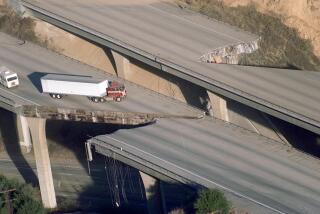U.S., Japan Plan Quake Research
- Share via
Japanese and American science officials have agreed on a new earthquake research partnership between the two countries, significantly expanding two 20-year-old science pacts.
One of the earliest projects of the Earthquake Disaster Mitigation Partnership will be a Japanese-financed but jointly designed shake table in Japan that will be the world’s largest to date.
Costing at least $600 million and able to shake a prototype five-story building, the 75-by-25-foot shake table will be finished shortly after the year 2000, a White House science official said.
The largest shake table in the United States is only about 20 feet square and is capable of testing only small models, which can behave differently in an earthquake than actual structures.
UC Berkeley structural engineering professor Stephen Mahin, a leading quake motion expert, said Monday that after the Japanese build the shake table, the United States will spend millions of dollars to build some of the structures to be tested.
The partnership was developed at a two-day conference at Stanford University in March and approved at a Washington, D.C., meeting Thursday of the Japanese minister for science and technology, Hidenao Nakagawa, White House science advisor John H. Gibbons and other administration officials.
Other priority themes for cooperative research, according to a joint communique, include earthquake prediction, models of expected damage, near-source quake motions, problems in the shaking of steel-frame buildings and controlling post-quake fires.
“Cooperation in science and technology will enhance our ability to reduce the damage to communities caused by earthquakes,” the communique declared.
Robert Hamilton, a U.S. Geological Survey seismologist who chaired the Stanford conference, said the Japanese investment in the shake table is only part of expanded Japanese research plans in the wake of last year’s Kobe earthquake.
“Their science and technology agency has an additional budget of $232 million,” he noted.
Hamilton and the Geological Survey’s Ken Hudnut, of the Pasadena office, also said the Japanese have expanded their network of Global Positioning System stations from 200 to 600 to detect strain rates near various faults.
By contrast, Southern California has about 40 such stations, and the whole United States about 30 more for earthquake purposes. There are another 30 in the country for navigational duties.
It is estimated that future Japanese earthquake research budgets will dwarf the current annual U.S. budget, which is about $100 million.
The White House science official nonetheless emphasized that the combined level of commitment in the two countries will allow for the most extensive earthquake research in history.
The new collaboration is the first between the two countries dealing solely with earthquakes. It goes beyond two earlier pacts that dealt more generally with science and technology and natural resources.
Berkeley’s Mahin said the new shake table alone will create an unprecedented opportunity to examine prototype buildings at real displacement levels.
“The Japanese table is being made so it can shake back and forth more than [three feet] at very large velocities, and these are motions that were experienced in the Santa Clarita Valley in 1994 and Kobe in 1995,” he explained.
By contrast, the largest displacement in U.S. shaking tables is only about five inches, he said.
“It’s not so much an issue of the force that is imposed by an earthquake on a building as of the ground motion,” Mahin said. “The new shake table will help us understand the real performance of structures.
“To simulate this in the past we had to use small-scale models that have raised many questions. Many things happen in large, full-size structures that don’t in small models. Steel and concrete properties change.”
But to take full advantage of the Japanese shake table, researchers in both countries will have to build elaborate structures and destroy them, he emphasized. “You need a fairly substantial research budget.”
More to Read
Sign up for Essential California
The most important California stories and recommendations in your inbox every morning.
You may occasionally receive promotional content from the Los Angeles Times.










